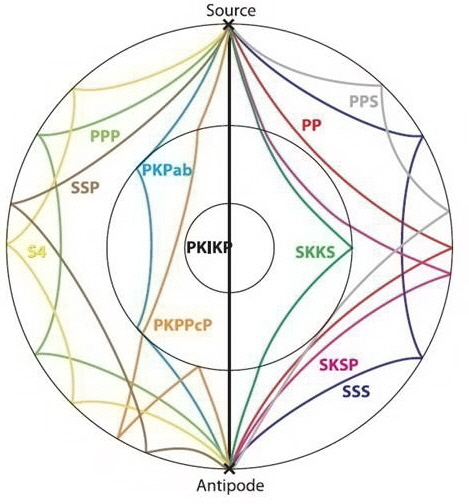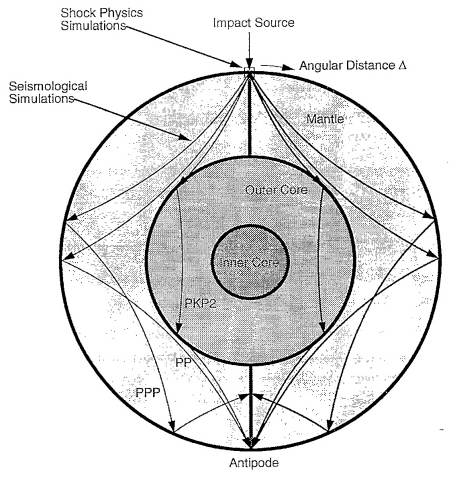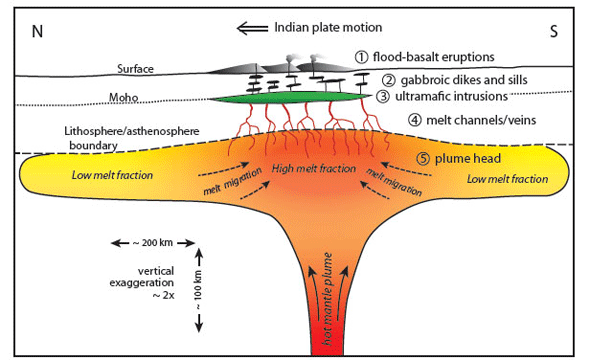Skip to comments.
Powerful Earthquakes Can Trigger Other Ones on Opposite Side of Earth, New Research Shows
Sci-News ^
| Aug 9, 2018
| News Staff / Source
Posted on 08/09/2018 10:55:39 AM PDT by ETL
It had been thought that aftershocks — smaller magnitude quakes that occur in the same region as the initial quake as the surrounding crust adjusts after the fault perturbation — were the only seismic activity an earthquake could lead to.
But the team’s analysis of seismic data from 1973 through 2016 provided the first discernible evidence that in the three days following one large quake, other earthquakes were more likely to occur.
Each test case in the study represented a single three-day window ‘injected’ with a large-magnitude (6.5 or greater) earthquake suspected of inducing other quakes, and accompanying each case was a control group of 5,355 three-day periods that didn’t have the quake injection.
“The test cases showed a clearly detectable increase over background rates,” Dr. O’Malley said.
“Earthquakes are part of a cycle of tectonic stress buildup and release. As fault zones near the end of this seismic cycle, tipping points may be reached and triggering can occur.”
The higher the magnitude, the more likely a quake is to trigger another quake.
Higher-magnitude quakes, which have been happening with more frequency in recent years, also seem to be triggered more often than lower-magnitude ones.
A tremblor is most likely to induce another quake within 30 degrees of the original quake’s antipode — the point directly opposite it on the other side of the globe.
“The understanding of the mechanics of how one earthquake could initiate another while being widely separated in distance and time is still largely speculative,” Dr. O’Malley said.
“But irrespective of the specific mechanics involved, evidence shows that triggering does take place, followed by a period of quiescence and recharge.”
(Excerpt) Read more at sci-news.com ...
TOPICS: Chit/Chat; Science
KEYWORDS: catastrophism; dinosaurs; gertakeller; paleontology
Navigation: use the links below to view more comments.
first 1-20, 21-30 next last
Seismic energy from a major meteorite impact would be expected to disrupt the surface on the opposite side of the Earth.2,13 The different types of wave phases are shown below.7 "In a perfectly spherically symmetrical structure, waves arrive simultaneously from all directions and focus exactly at the antipode.
As a consequence of the 3-D heterogeneity in the Earth, waves coming to the antipode from different directions do not arrive exactly simultaneously. These differences in traveltimes of waves coming from different directions distort the perfect focusing". P-waves, especially PP and PKPab, are strongest and most focused, while S-waves tend to be more disturbed by heterogeneities in the Earth.7

Computer simulations conducted at Sandia National Laboratories in 1994 produced the wave paths shown here.2

How much disruption would be caused has been debated among researchers. Some argue that volcanic "hotspots" and even flood basalts could be triggered by antipodal effects,3 while others find the energy reaching the antipode to be insufficient to cause volcanism.4 Disrupted terrain, and possibly volcanism, are thought to have been found antipodal to large impact craters on the Moon, Mars, and Mercury.13,15
Source:
1
posted on
08/09/2018 10:55:39 AM PDT
by
ETL
To: ETL
2
posted on
08/09/2018 11:00:22 AM PDT
by
GOP Poet
To: ETL
It’s like they’re all connected or sumthin.
3
posted on
08/09/2018 11:01:23 AM PDT
by
Lurkina.n.Learnin
(Wisdom and education are different things. Don't confuse them.)
To: ETL
Didn’t Tesla conduct tests to prove this could be done with transmitting electrical energy as well?
4
posted on
08/09/2018 11:03:53 AM PDT
by
montag813
To: ETL
I rather took it for granted.
To: ETL
Interesting. Dutchsinse (Michael Janitch) has been telling the scientific community this for about five years now.
He also predicts earthquakes every day on his Youtube channel, and is extremely accurate, which is most likely why they keep taking his channel down. It is up at the moment.
6
posted on
08/09/2018 11:04:57 AM PDT
by
Norski
To: ETL
I’ve seen this movie......................
7
posted on
08/09/2018 11:06:06 AM PDT
by
Red Badger
(July 2018 - the month the world learns the TRUTH......Q Anon)
To: montag813
I think he went broke and died before he could try it...............
8
posted on
08/09/2018 11:07:21 AM PDT
by
Red Badger
(July 2018 - the month the world learns the TRUTH......Q Anon)
To: All
Related...
Did dinosaur-killing asteroid trigger largest lava flows on Earth?
By Robert Sanders, Media relations
April 30, 2015
The asteroid that slammed into the ocean off Mexico 66 million years ago and killed off the dinosaurs probably rang the Earth like a bell, triggering volcanic eruptions around the globe that may have contributed to the devastation, according to a team of UC Berkeley geophysicists.
Specifically, the researchers argue that the impact likely triggered most of the immense eruptions of lava in India known as the Deccan Traps, explaining the “uncomfortably close” coincidence between the Deccan Traps eruptions and the impact, which has always cast doubt on the theory that the asteroid was the sole cause of the end-Cretaceous mass extinction.

Mark Richards sampling a weathered zone between two lava flows of the Deccan Traps, near the town of Mahabeleshwar, India. These zones, locally called “red boles,” may represent periods of time elapsed between the eruption of successive gigantic lava flows. (Paul Renne photo)
“If you try to explain why the largest impact we know of in the last billion years happened within 100,000 years of these massive lava flows at Deccan … the chances of that occurring at random are minuscule,” said team leader Mark Richards, UC Berkeley professor of earth and planetary science. “It’s not a very credible coincidence.”
Richards and his colleagues marshal evidence for their theory that the impact reignited the Deccan flood lavas in a paper to be published in The Geological Society of America Bulletin, available online today (April 30) in advance of publication.
While the Deccan lava flows, which started before the impact but erupted for several hundred thousand years after re-ignition, probably spewed immense amounts of carbon dioxide and other noxious, climate-modifying gases into the atmosphere, it’s still unclear if this contributed to the demise of most of life on Earth at the end of the Age of Dinosaurs, Richards said.
“This connection between the impact and the Deccan lava flows is a great story and might even be true, but it doesn’t yet take us closer to understanding what actually killed the dinosaurs and the ‘forams,’” he said, referring to tiny sea creatures called foraminifera, many of which disappeared from the fossil record virtually overnight at the boundary between the Cretaceous and Tertiary periods, called the KT boundary. The disappearance of the landscape-dominating dinosaurs is widely credited with ushering in the age of mammals, eventually including humans.
He stresses that his proposal differs from an earlier hypothesis that the energy of the impact was focused around Earth to a spot directly opposite, or antipodal, to the impact, triggering the eruption of the Deccan Traps. The “antipodal focusing” theory died when the impact crater, called Chicxulub, was found off the Yucatán coast of Mexico, which is about 5,000 kilometers from the antipode of the Deccan traps.
Flood basalts
Richards proposed in 1989 that plumes of hot rock, called “plume heads,” rise through Earth’s mantle every 20-30 million years and generate huge lava flows, called flood basalts, like the Deccan Traps. It struck him as more than coincidence that the last four of the six known mass extinctions of life occurred at the same time as one of these massive eruptions.

Illustration of a hot mantle plume “head” pancaked beneath the Indian Plate. The theory by Richards and his colleagues suggests that existing magma within this plume head was mobilized by strong seismic shaking from the Chicxulub asteroid impact, resulting in the largest of the Deccan Traps flood basalt eruptions.
“Paul Renne’s group at Berkeley showed years ago that the Central Atlantic Magmatic Province is associated with the mass extinction at the Triassic/Jurassic boundary 200 million years ago, and the Siberian Traps are associated with the end Permian extinction 250 million years ago, and now we also know that a big volcanic eruption in China called the Emeishan Traps is associated with the end-Guadalupian extinction 260 million years ago,” Richards said. “Then you have the Deccan eruptions – including the largest mapped lava flows on Earth – occurring 66 million years ago coincident with the KT mass extinction. So what really happened at the KT boundary?”
Richards teamed up with experts in many areas to try to discover faults with his radical idea that the impact triggered the Deccan eruptions, but instead came up with supporting evidence. Paul Renne, a professor in residence in the UC Berkeley Department of Earth and Planetary Science and director of the Berkeley Geochronology Center, re-dated the asteroid impact and mass extinction two years ago and found them essentially simultaneous, but also within approximately 100,000 years of the largest Deccan eruptions, referred to as the Wai subgroup flows, which produced about 70 percent of the lavas that now stretch across the Indian subcontinent from Mumbai to Kolkata.
Michael Manga, a professor in the same department, has shown over the past decade that large earthquakes – equivalent to Japan’s 9.0 Tohoku quake in 2011 – can trigger nearby volcanic eruptions. Richards calculates that the asteroid that created the Chicxulub crater might have generated the equivalent of a magnitude 9 or larger earthquake everywhere on Earth, sufficient to ignite the Deccan flood basalts and perhaps eruptions many places around the globe, including at mid-ocean ridges.
“It’s inconceivable that the impact could have melted a whole lot of rock away from the impact site itself, but if you had a system that already had magma and you gave it a little extra kick, it could produce a big eruption,” Manga said.
Similarly, Deccan lava from before the impact is chemically different from that after the impact, indicating a faster rise to the surface after the impact, while the pattern of dikes from which the supercharged lava flowed – “like cracks in a soufflé,” Renne said – are more randomly oriented post-impact.
“There is a profound break in the style of eruptions and the volume and composition of the eruptions,” said Renne. “The whole question is, ‘Is that discontinuity synchronous with the impact?’”
Reawakened volcanism
Richards, Renne and graduate student Courtney Sprain, along with Deccan volcanology experts Steven Self and Loÿc Vanderkluysen, visited India in April 2014 to obtain lava samples for dating, and noticed that there are pronounced weathering surfaces, or terraces, marking the onset of the huge Wai subgroup flows. Geological evidence suggests that these terraces may signal a period of quiescence in Deccan volcanism prior to the Chicxulub impact. Apparently never before noticed, these terraces are part of the western Ghats, a mountain chain named after the Hindu word for steps.
“This was an existing massive volcanic system that had been there probably several million years, and the impact gave this thing a shake and it mobilized a huge amount of magma over a short amount of time,” Richards said. “The beauty of this theory is that it is very testable, because it predicts that you should have the impact and the beginning of the extinction, and within 100,000 years or so you should have these massive eruptions coming out, which is about how long it might take for the magma to reach the surface.”

Photograph of part of the main stack of 66 million year old Deccan Traps lava flows near the city of Mahabaleshwar, India. The entire volume of the Deccan Traps could have covered an area as large as the state of California in a mile deep pile of lava flows.(Mark Richards photo)
Since the team’s paper was accepted for publication, a group from Princeton University published new radioisotopic dates for the Deccan Traps lavas that are consistent with these predictions. Renne and Sprain at UC Berkeley also have preliminary, unpublished dates for the Deccan lavas that could help solidify Richards’ theory, Renne said.
Co-authors of the paper, in addition to Richards, Renne, Manga and Sprain, are Walter Alvarez, a UC Berkeley professor emeritus of earth and planetary science and the co-originator of the dinosaur-killing asteroid theory; Stephen Self, an adjunct professor in the same department at UC Berkeley; Leif Karlstrom of the University of Oregon; Jan Smit of Vrije Universeit in Amsterdam, the Netherlands; Loÿc Vanderkluysen of Drexel University in Philadelphia, Pennsylvania; and Sally A. Gibson of the University of Cambridge in the United Kingdom.
http://news.berkeley.edu/2015/04/30/did-dinosaur-killing-asteroid-trigger-largest-lava-flows-on-earth/
9
posted on
08/09/2018 11:08:43 AM PDT
by
ETL
(Obama-Hillary, REAL Russia collusion! Uranium-One Deal, Missile Defense, Iran Deal, Nukes: Click ETL)
To: Norski
I still get youtube notifications, but i think the live stream moved... cant remember new site, twitch maybe?
To: Red Badger
Does this mean that on or about 11/8/2016, some Asian was elected to make their Asian country great again?
11
posted on
08/09/2018 11:10:54 AM PDT
by
C210N
(Republicans sign check fronts; 'Rats sign check backs.)
To: All
Re: Did dinosaur-killing asteroid trigger largest lava flows on Earth?

12
posted on
08/09/2018 11:11:22 AM PDT
by
ETL
(Obama-Hillary, REAL Russia collusion! Uranium-One Deal, Missile Defense, Iran Deal, Nukes: Click ETL)
To: C210N
Yes, Rodrigo Duterte.............
13
posted on
08/09/2018 11:13:21 AM PDT
by
Red Badger
(July 2018 - the month the world learns the TRUTH......Q Anon)
To: ETL
I used this
Antipode Calculator to find out what's on the opposite side of my place, and luckily it's in the middle of the Indian Ocean. And everybody knows there are never earthquakes on the ocean fl...
Uh oh. I'm screwed.
To: ETL
So all we have to do to destroy our enemies is cause a really massive earthquake at the right point here.
15
posted on
08/09/2018 11:17:20 AM PDT
by
DannyTN
To: ETL
So all we have to do to destroy our enemies is cause a really massive earthquake at the right point here.
16
posted on
08/09/2018 11:17:22 AM PDT
by
DannyTN
To: ETL
I heard that on Art Bell twenty years ago.
17
posted on
08/09/2018 11:36:45 AM PDT
by
dljordan
(WhoVoltaire: "To find out who rules over you, simply find out who you are not allowed to criticize.")
To: Norski
DUTCHSINSE was forced off YouTube. The latest was when YouTube deleted his program warning about the recent 7.0 earthquake on the Indonesian island of Lombok. Many deaths could have been prevented if the scientific community had posted DUTCH'S earthquake warning.
The USGA and others want to take the credit for his research. He is on TWIX TV. People need to make him known. I post his site whenever I can on Free Republic.
DUTCHSINSE Earthquake3D live stream -- 24/7 seismic activity
18
posted on
08/09/2018 11:38:17 AM PDT
by
stars & stripes forever
(Blessed is the nation whose God is the Lord. Psalm ( 32:12))
To: Billthedrill
I used this Antipode Calculator to find out what's on the opposite side of my placeInteresting. Will give it a try. Thanks.
19
posted on
08/09/2018 11:51:42 AM PDT
by
ETL
(Obama-Hillary, REAL Russia collusion! Uranium-One Deal, Missile Defense, Iran Deal, Nukes: Click ETL)
To: stars & stripes forever
20
posted on
08/09/2018 11:57:53 AM PDT
by
BenLurkin
(The above is not a statement of fact. It is either satire or opinion. Or both.)
Navigation: use the links below to view more comments.
first 1-20, 21-30 next last
Disclaimer:
Opinions posted on Free Republic are those of the individual
posters and do not necessarily represent the opinion of Free Republic or its
management. All materials posted herein are protected by copyright law and the
exemption for fair use of copyrighted works.
FreeRepublic.com is powered by software copyright 2000-2008 John Robinson





